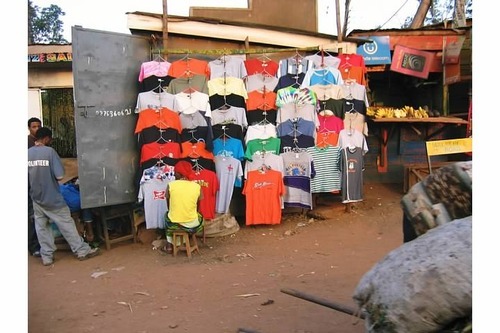Visual Ethnography and Reality

I shot the photograph above while on a trip to East Africa. The context in which the image was taken in is extremely meaningful because it is profoundly familiar, significant and it evokes many emotions. In an effort to understand more about visual ethnography and reality, I decided to study the photo of colorful T-shirts in light of Pink’s insights.
From a participants’ perspective, the image shows a market where my family regularly purchases food items. It might not appear so for the onward viewer since most of what meets the eye are many T-shirts, in this case second hand or used ones. For instance, when I assume the position of an informant, it would be necessary to consider the background that surrounds the business women’s boutique. There are some more details to disclose and in fact if a viewer sticks with the immediate impression, zooms in to the lower left corner, she or he would not miss the enterprising lady seated on a four legged stool and dressed in a bright yellow top. A quick glance to the extreme right and it becomes obvious that she is also trading in food mainly “sweet bananas”. Though a picture communicates a thousand words, it might be difficult to visualize actual size of the vicinity from which the snapshot was extracted, but take my word as an informant; the market is rather sizable.
The gentleman to the extreme left are barbers waiting for clients to support their day job carried out in the shop with glittery drapes behind the grey metal door. As a researcher, I could explain the socioeconomic forces at play, political climate and cultural dynamics exhibited in the photograph. Like “Encarni”[1] from Spain who Pink mentions in Doing Visual Ethnography, I have functioned as an informant, participant and researcher.
Prior to engaging with the course material on ethnography, I was not aware of the possible categories of informant and participant as much I was with researcher. While reading Pink’s story about Encarni’s experience with the researcher who was interested in investigating the image of a ‘traditional woman’ in Spain, I was encouraged to identify and appreciate the labels as they pertain to the discipline. It was also consoling to know that it is possible to genuinely immerse into a host cultural context with such acceptable capacities. However, the question of how to preserve ethnographic reality is still of great significance. The call for the need for sensitivity is valid when capturing images in any given context. It is clear to me that Pink also advocates for the same mindfulness and emphasizes the need for the formation of partnerships between researcher and informant in order to stay close to reality, culture and contextual experience. Pink notes:
Moreover, a linear visual chronology may not consistently represent the way in which reality was experienced or conceptualized by all the individuals involved. Narratives and sequences are not necessarily fixed. The order in which events and activities are experience may change, and the orders in which they are remembered and spoken about may differ from the chronological order in which they happened.[2]
The question that continues knock at the door of my curiosity when it comes to ethnography and reality is; what is the role and place of imagination and creativity when it comes to the need to be sensitive and respectful of people’s context and communities?
Leave a Reply
You must be logged in to post a comment.